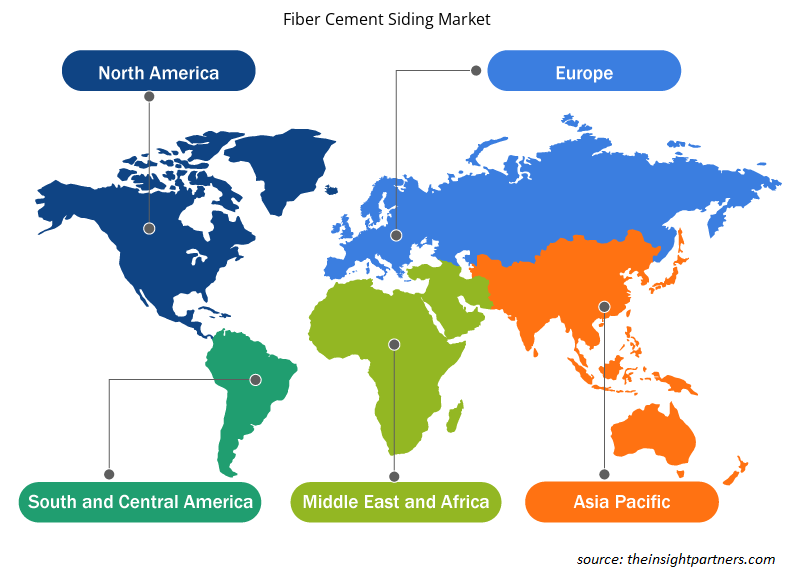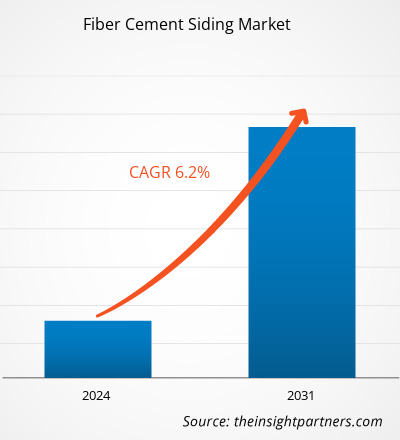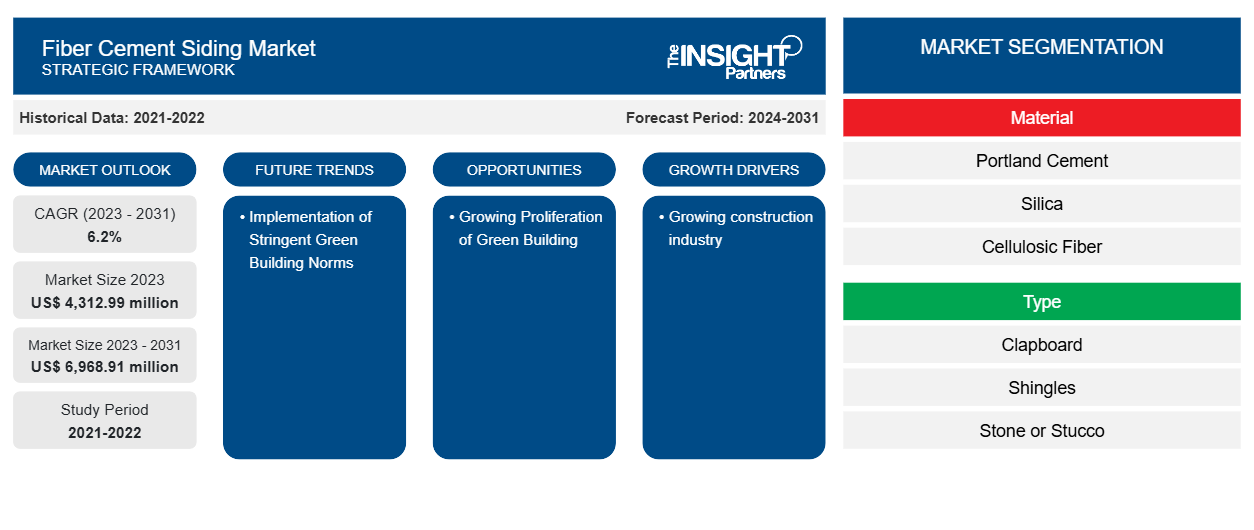纤维水泥壁板市场规模预计将从 2023 年的 43.1299 亿美元增至 2031 年的 69.6891 亿美元。预计 2023-2031 年期间,该市场的复合年增长率将达到 6.2%。住宅和商业基础设施开发数量的不断增加以及对利用成本效益高的水泥壁板的日益关注可能仍将是市场的主要趋势。
纤维水泥壁板市场分析
建筑业的不断发展预计将促进全球纤维水泥壁板的发展。过去几年,美国、加拿大、英国等发达国家的建筑业一直以显著的速度增长。这些国家的政府鼓励公私合作实施住宅、商业和基础设施工程。这进一步导致近年来全球住宅和商业建筑的建设增多,从而促进了纤维水泥壁板市场的增长。
纤维水泥壁板市场概况
住宅和商业建筑建设的增加预计将为全球市场增长提供繁荣的机会,从而对纤维水泥壁板的需求产生积极影响。除此之外,智慧城市项目也成为纤维水泥壁板市场的驱动力。由于经济繁荣,个人可支配收入增加是推动住宅建筑领域纤维水泥壁板市场发展的主要因素。因此,建筑活动数量的增加导致全球对纤维水泥壁板的需求增加。
定制此报告以满足您的需求
您可以免费定制任何报告,包括本报告的部分内容、国家级分析、Excel 数据包,以及为初创企业和大学提供优惠和折扣
-
获取此报告的关键市场趋势。这个免费样品将包括数据分析,从市场趋势到估计和预测。
纤维水泥壁板市场驱动因素和机遇
建筑业蓬勃发展 利好市场
人口增长导致全球对住宅和商业建筑活动的需求旺盛。欧洲、北美、亚太地区和中东等地区由多个发展中国家组成,对基础设施项目的需求强劲。这些国家人口的增加是该地区住房行业的主要驱动力,这将推动全球纤维水泥壁板市场的发展。随着商业和住宅建筑的蓬勃发展,纤维水泥壁板市场在中国和日本等多个国家呈增长趋势,因为它具有多种优势,例如长期节省能源和成本、降低排放和总体环境影响、更好的热舒适度,并且整个建筑内持续通风和新鲜空气可提高舒适度和健康水平。节能建筑的概念日益兴起也推动了纤维水泥壁板市场的增长。
绿色建筑日益普及
政府推出的多项节能环保建筑举措正在推动纤维水泥壁板市场的需求。例如,德国和英国是主要致力于建设节能建筑的国家,因为两国政府都进行了投资。这一因素正在推动纤维水泥壁板市场的增长。住宅和商业住房领域的技术进步符合环境可持续发展目标,预计将吸引本地和全球参与者提供优质的纤维水泥壁板,预计在预测期内,这将为市场带来更多机会。
纤维水泥壁板市场报告细分分析
有助于得出纤维水泥壁板市场分析的关键部分是产品类型、应用和最终用户。
- 根据材料,纤维水泥壁板市场分为波特兰水泥、二氧化硅、纤维素纤维等。波特兰水泥部分在 2023 年占据了较大的市场份额。
- 根据类型,市场分为隔板、木瓦和石材或灰泥。隔板部分在 2023 年占据了相当大的市场份额。
- 根据终端用户,市场分为住宅和商业。2023 年,住宅市场占据了相当大的市场份额。
纤维水泥壁板市场份额按地区分析
纤维水泥壁板市场报告的地理范围主要分为五个地区:北美、亚太、欧洲、中东和非洲、南美和中美。
北美是市场领导者。北美经济被认为是世界上最大的经济体之一。北美国家拥有其领土内一些最大的跨国公司。与世界相比,美国拥有更多的纤维水泥壁板市场参与者。位于该地区的建筑公司受益于发达的设施。强劲的经济使政府能够在建筑工程上投入更多资金,以实现更多的城市化。这也有助于该地区的建筑物建设,从而支持该地区的纤维水泥壁板市场增长。
纤维水泥壁板市场区域洞察
Insight Partners 的分析师已详尽解释了预测期内影响纤维水泥壁板市场的区域趋势和因素。本节还讨论了北美、欧洲、亚太地区、中东和非洲以及南美和中美洲的纤维水泥壁板市场细分和地理位置。

- 获取纤维水泥壁板市场的区域特定数据
纤维水泥壁板市场报告范围
| 报告属性 | 细节 |
|---|---|
| 2023 年的市场规模 | 43.1299亿美元 |
| 2031 年市场规模 | 69.6891亿美元 |
| 全球复合年增长率(2023 - 2031) | 6.2% |
| 史料 | 2021-2022 |
| 预测期 | 2024-2031 |
| 涵盖的领域 |
按材质
|
| 覆盖地区和国家 |
北美
|
| 市场领导者和主要公司简介 |
|
市场参与者密度:了解其对商业动态的影响
纤维水泥壁板市场正在快速增长,这得益于最终用户需求的不断增长,这些需求源于消费者偏好的不断变化、技术进步以及对产品优势的认识不断提高等因素。随着需求的增加,企业正在扩大其产品范围,进行创新以满足消费者的需求,并利用新兴趋势,从而进一步推动市场增长。
市场参与者密度是指在特定市场或行业内运营的企业或公司的分布情况。它表明在给定市场空间中,相对于其规模或总市场价值,有多少竞争对手(市场参与者)存在。
在纤维水泥壁板市场运营的主要公司有:
- Swisspearl 集团
- 中国社会责任有限公司
- Elementia SAB DE CV
- ETEX 集团
- GAF材料公司
- 詹姆斯哈迪工业公司
免责声明:上面列出的公司没有按照任何特定顺序排列。

- 了解纤维水泥壁板市场主要参与者概况
纤维水泥壁板市场新闻和最新发展
通过收集一手和二手研究后的定性和定量数据来评估纤维水泥壁板市场,其中包括重要的公司出版物、协会数据和数据库。以下列出了纤维水泥壁板市场的一些发展情况:
- 瑞士下乌尔嫩的 Swisspearl 集团收购了丹麦的 Cembrit。(来源:Swisspearl 集团,新闻稿,2022 年 6 月)
- James Hardie Industries Plc 在维多利亚州墨尔本收购土地,建立纤维水泥板厂。(来源:James Hardie Industries Plc,新闻稿,2022 年 3 月)
纤维水泥壁板市场报告覆盖范围和交付成果
“纤维水泥壁板市场规模和预测(2021-2031 年)”报告对以下领域进行了详细的市场分析:
- 纤维水泥壁板市场规模及全球、区域和国家层面所有主要细分市场的预测
- 纤维水泥壁板市场趋势以及市场动态,如驱动因素、限制因素和关键机遇
- 详细的 PEST 和 SWOT 分析
- 纤维水泥壁板市场分析涵盖主要市场趋势、全球和区域框架、主要参与者、法规和最新市场发展
- 行业格局和竞争分析,涵盖市场集中度、热图分析、知名参与者以及纤维水泥壁板市场的最新发展
- 详细的公司简介
- 历史分析(2 年)、基准年、预测(7 年)及复合年增长率
- PEST和SWOT分析
- 市场规模、价值/数量 - 全球、区域、国家
- 行业和竞争格局
- Excel 数据集
近期报告
相关报告
客户评价
购买理由
- 明智的决策
- 了解市场动态
- 竞争分析
- 客户洞察
- 市场预测
- 风险规避
- 战略规划
- 投资论证
- 识别新兴市场
- 优化营销策略
- 提升运营效率
- 顺应监管趋势























 获取免费样品 - 纤维水泥壁板市场
获取免费样品 - 纤维水泥壁板市场